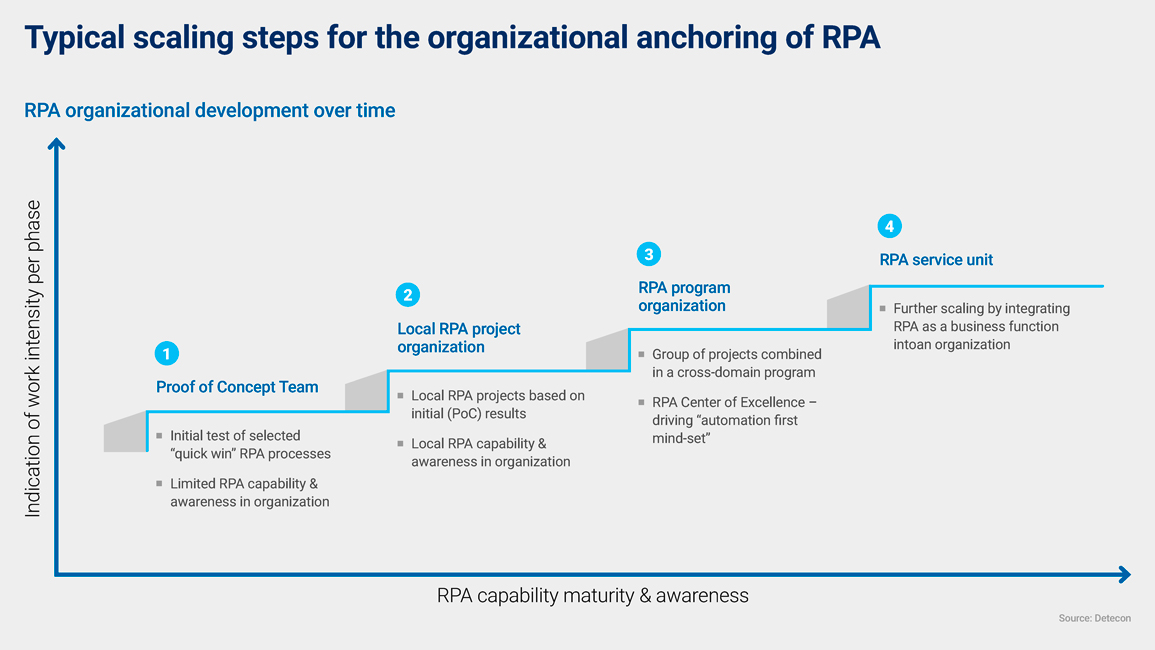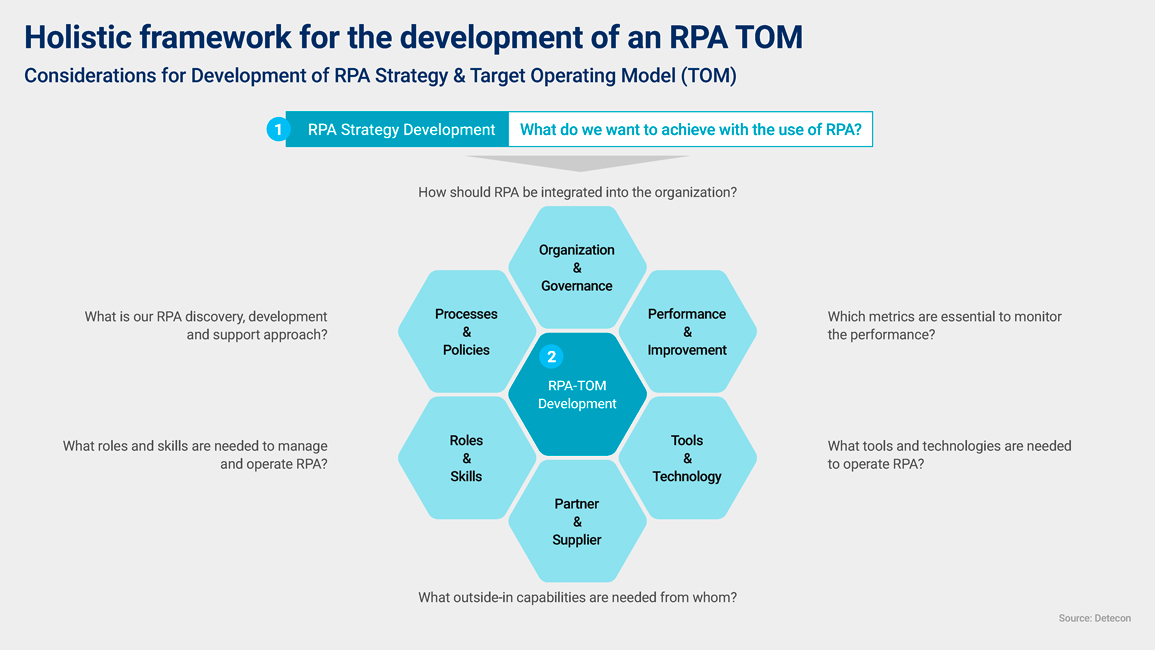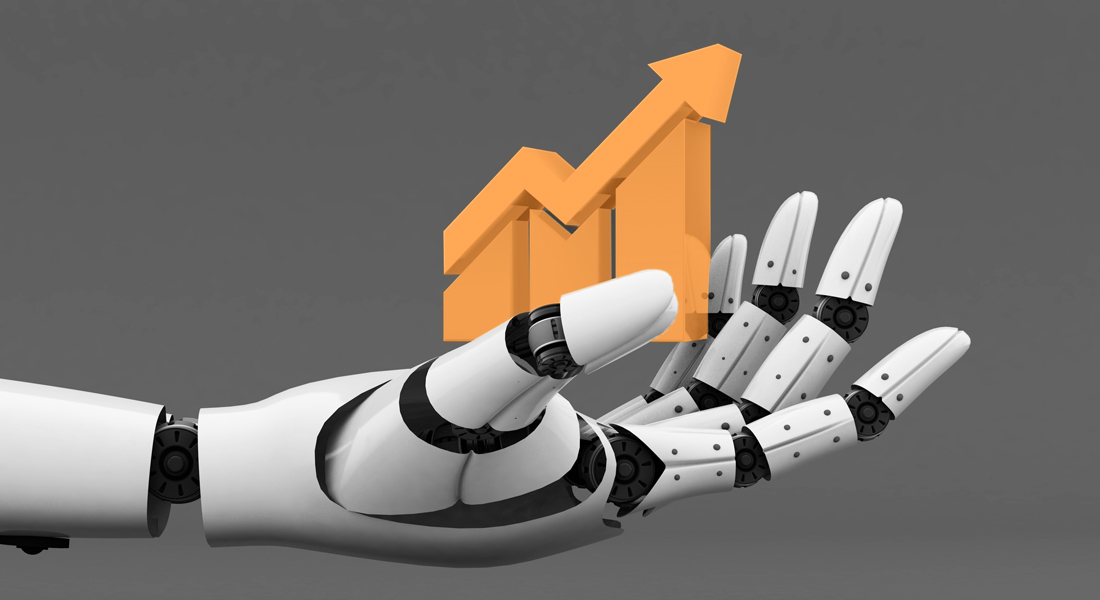Robotic Process Automation (RPA) has established itself as a technology and is used in many companies today - although unfortunately often still only opportunistically and project-driven. In order to develop the operational advantages into real strategic added value, it is necessary to anchor the technology in the company for the long term and to scale it in a coordinated manner along all process areas. This ensures that RPA increases both efficiency and effectiveness.
RPA is emerging from its infancy. According to the Lünendonk Study on Digital Efficiency, around 80% of the companies surveyed rate the use of RPA as "partially advanced". However, only 15% of respondents also see its use as "well advanced." This result suggests that most companies are currently facing the challenge of scaling.
RPA "Proof-of-Concepts" as an entry into automation
When used correctly, Robotic Process Automation (RPA) is a very effective tool to free employees from tedious rule-based tasks, to couple non-integrated systems without costly development projects and to achieve improved cost efficiency, cycle time and process quality. The fact that this is not only true in theory has been confirmed via various Proof-of-Concepts (PoC) over the past years.
A PoC is usually understood as the automation of one or two use cases, which are implemented quickly and unbureaucratically, detached from governance. All you need for a PoC are:
- valid use cases suitable for automation with RPA dedicated resources from the department to assist with content-related issues
- enough test cases to test the bot
- a quickly deployable and cost-effective RPA platform
- Management buy-in that drives automation.
A PoC can certainly be seen as a good introduction to the topic of RPA, as initial experience points can be gathered and advantages quickly demonstrated. However, in order to make RPA an integral part of digitization within the company, it is important to move away from experimentation toward sustainable transformation. Companies need to build capabilities, for example regarding the efficient use of a "digital workforce", to establish the long-term goal of digitization. How RPA can be operationalized and why this is so important is described below.
After the first successful RPA pilot projects, the first problems often arise when trying to scale. This results in a lack of professionalism in operations and problems in delivering RPA as an IT service. A holistic end-to-end view of process chains across different domains and a cost-effective scalability of the topic of RPA through, for example, centralization of infrastructure remain unachieved for the time being. As a possible solution, the concept of an RPA service unit and the transformation path to this will now be demonstrated.
Steps towards sustainable RPA scaling
If RPA is to be used sustainably in the long term, the technology must be transferred and anchored in the organization. The challenge here is to find an organizational form that enables the professional provision of RPA services for the respective company.
Starting from the PoC team, which was already active for the implementation of proof-of-concepts, many companies introduce dedicated RPA project teams for specific domains. These project teams launch automation initiatives related to individual company domains, such as Finance & Controlling or Procurement. As the number of use cases and maintenance efforts increase, one often observes scaling to an RPA program tasked with implementing RPA across multiple domains.
The next logical scaling step is the creation of a fixed central unit with the mandate to sustainably and continuously ensure and coordinate the enterprise-wide deployment of RPA. The fixed tasks of such an RPA Unit include:
- Discovery: Support of the business units for the identification of automation potentials
- Business Casing & Roadmapping: Evaluation of automation potentials, prioritization and implementation planning
- Development: Development of RPA bots, testing and production implementation
- Support/Assurance: Ensuring operation and fault clearance in the event of incidents
- Plattform & Tooling: Introduction and maintenance of the RPA platform as well as other support tools (e.g. to support discovery or support processes)
- Process, People & Performance: Sustainable development and assurance of relevant skills/competencies and continuous monitoring and improvement of service processes
Typically, such RPA service units are assigned to the existing corporate functions of IT, process or quality management - depending on the question of which professional and technical competencies and responsibilities already exist in which teams. The following illustration shows the typical scaling steps for the organizational anchoring of RPA:

Figure 1: Typical scaling steps for the organizational anchoring of RPA
Compared to a typically temporary RPA program organization, a firmly anchored RPA service unit offers decisive added value. On the one hand, the bundling of competencies, responsibilities and resources in a centralized unit significantly increases effectiveness and efficiency. On the other hand, the centralized infrastructure and operation, as well as the systematic holistic view along all company domains, enable a true continuous improvement process to tap automation potential.
The introduction of such an RPA service unit naturally requires an automation strategy and corresponding management commitment. If these prerequisites are not yet in place, an RPA Service Center is often mapped in a virtualized team structure - in the form of a so-called Center of Excellences (CoE). In such a structure, distributed experts, for example from IT or the business departments, work together on the implementation of RPA over the long term - often not exclusively, but in parallel with other topics.
Development of a "Target Operating Model" for the introduction of an RPA Service Unit
The development of a target operating model (TOM) is recommended for the introduction of an RPA service unit. As an instrument, the TOM offers a holistic orientation framework for defining and designing all relevant aspects for the introduction or anchoring of new operational functions.
The typical issues that should be considered when introducing a new business function naturally include defining the necessary roles and processes and developing the corresponding organizational and governance structures. In terms of a holistic design, however, the approaches should also be defined with regard to partnering, tooling or even performance measurability. Based on empirical values from possible projects, Detecon has developed a holistic framework for the development of an RPA TOM:

Figure 2: Holistic framework for the development of an RPA TOM
The advantages of an RPA Service Unit lie in the increase of effectiveness and efficiency
Numerous companies have gained initial experience with the use of RPA technologies - but only in rudimentary form within the framework of PoCs or projects. In order to develop the operational advantages into real strategic added value, an operational anchoring in the direction of an RPA Service Unit designed for the long term and a coordinated scaling along all process areas is required.
The advantages of an RPA Service Unit lie in the increase in effectiveness and efficiency - driven primarily by the bundling of competencies, responsibilities and resources in a centralized unit. In addition, the centralized infrastructure and operations create an important foundation for a true continuous improvement process.
For the introduction of an RPA Service Unit, the development of a so-called Target Operating Model (TOM) is recommended as a holistic orientation framework for the definition and design of all relevant aspects for the introduction of an RPA Service Unit.







